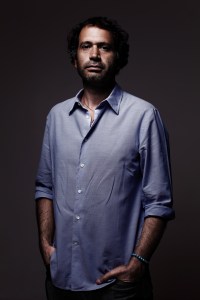Bosco Sodi, Untitled, 2013
Mexican painter Bosco Sodi works in the tradition of Abstract Expressionism, creating large-scale canvases that evoke a scorched, cracked earth in a variety of vivid colors. By constructing a conversation between himself as artist and the raw materials he employs, Sodi infuses an effusive spirituality in his pieces. He also values the emotional power of his art: “I think painting at this time has a big responsibility to help people to heal and to show people that life is impermanent.”
You live and work in a number of places: New York, Mexico City, Barcelona, Berlin. How does all this moving around influence your art?
I try to find in my work as much as possible things that I cannot control. I like to move from studio to studio because the environment in each studio is completely different: the weather, the humidity, even the sawdust in each studio is different because it comes from different wood or different suppliers. Even if I travel with pigments from one place to another, the outcome of the painting is completely different if I do it in New York or Berlin because when I mix the pigments with the sawdust, it makes a slightly different color, or the cracking is different because of the weather. So that’s why I like to maintain different studios because I’m very interested in this kind of influence by the environment of the place.
How did you develop the cracking process in which you make your paintings?
The way I approach art is that it’s very much about the process, about the researching. I was producing my old paintings—they didn’t have as much texture as these ones—and one day I was researching and I left out a big quantity of this material that I use normally. I found it very interesting how it began to crack and how I lost control of the painting completely. This part that you don’t control—it’s ruled by nature, by other forces, not by the artist.
Since you prefer to let the painting happen organically, how much of a canvas do you plot out ahead of time?
Normally when I go the studio I arrive without any idea, with an empty mind. Really the only limitation I put to the painting is the size of the canvas. I choose the canvas I want, I choose the sawdust I want to use, the pigments—normally I work on series, so I know what range of colors I’m going to do. I buy pigments all around the world, so none of them work exactly the same.
What was the inspiration for your latest series? How did you decide to use graphite?
I have been doing for a long time what we can call very organic colors. When they dry, they give the feeling of a live organism. And I wanted to look for the feeling of rock—completely organic but having this same feeling of cracking. With each pigment and organic materials that I use, I let the painting be completely unique. All of them are not repeatable. So I wanted to change it up and have another reaction from the viewer, to confront them with something much colder than my other organic works. These ones are made with organic materials and minerals like graphite. When you see them, they deliver a completely different feeling.
(MORE: Master Photographer: Q&A with Terry O’Neill)
How do you intend for viewers to interact with your work?
What I ask of the viewer is to come with a completely empty mind. I try to avoid any kind of guidance to the viewer or hints; that’s why I don’t put titles on them, and I sign them on the back. I want the viewer to have no preconceptions and just get into the painting, feel whatever they feel like. For example, when you see a salsa, a salsa doesn’t need an explanation. The salsa makes some reaction inside you, and that’s the way I want viewers to see my paintings. I want viewers to feel them and make their own conclusions.
How long does it take you to complete each piece?
My action is very short. The whole process takes two or two and a half months, but my action in the painting is not more than a week. I don’t work on them once they dry. As soon as they begin to dry I prefer to get out and leave the process to run by itself, because I think that if I stay there, I begin to dictate a little bit the outcome, and I don’t like that. I want the outcome to be completely out of my hands.
Can you ever see yourself creating figurative works?
For me it’s difficult. I have done it before, but just as a hobby. Sometimes I do some drawings at home, but really what I feel comfortable with—because for me it’s much more an inner exercise—is with abstraction. With figurative works, you have more control and it’s more about technique. I admire it a lot, but abstraction is much more about freedom. It’s completely different.
Bosco Sodi’s latest exhibition will be on view at Pace Gallery London September 6 – October 4.
MORE: The Creative Mind: Q&A with Fashion Photographer Inez van Lamsweerde


